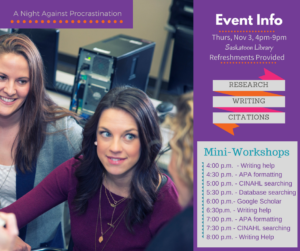By Gina Brander & Ann Liang
Saskatchewan Polytechnic Library
Stress Better is a semiannual Saskatchewan Polytechnic Library event designed to help students combat stress as they prepare for exams. As part of our 2017 event, the Library piloted an escape room at the Regina campus. Escape rooms are physical adventure games in which active participants solve a series of clues and puzzles to escape a room before the allotted time elapses. Academic libraries have used escape rooms for staff development workshops (Marks, 2017), library orientations (Salisbury & Ung, 2016), and library instruction (Pun, 2017). While our Library considered incorporating an information literacy component into the event, we ultimately decided that a fun, escapist approach would generate more interest and better support the aims of Stress Better. Given that many of our students more or less lock themselves in the library during this period of the semester, the irony of a library escape room was particularly appealing.
Outreach
Since no one on staff knew the first thing about running an escape room, we decided to reach out to local businesses and ask if they would be interested in developing a mini version of one of their rooms. Emails were sent to three local escape rooms, emphasizing the promotional benefits of the partnership and making clear that we would not offer remuneration. To our delight, all three rooms expressed interest in assisting with the escape room. The Library chose to partner with a local, family-run business that had received favourable reviews online, and which had offered to design a new room based on our individual needs.
Planning
Over the next week, the escape room co-owner and a librarian selected an appropriate space (a small, windowless study room), determined length of gameplay (15 minutes) and discussed potential storylines based on available library furniture and props (weeded books, filing cabinets, whiteboards, wall-hangings, etc.). The co-owner developed the design and flow of the room. Then, a week before the event, the room was closed to allow for set up and testing. A script and reset list were prepared for the Library, and a faculty group was invited to trial the room before the official launch.
Promotion
A variety of promotional methods were used. Due to the high foot traffic at the Regina campus, a chalkboard near the entrance and our frontline staff were the most effective channels of promotion. Participants returned to the library throughout the week to inquire about best time, which inspired us to promote a ‘time to beat’ on print posters and social media. This added competitive element kept the momentum going, and as the week progressed, we opened additional time slots at the request of students and faculty/staff.
Run & Reset
A staff member greeted each group and led them to the escape room. After laying down ground rules and introducing the scenario, they closed the (unlocked) door and set the clock. Each group was granted three clues, which could be requested via walkie-talkie. After the allotted time had elapsed (or after the group had ‘escaped’), the staff member returned to the room to debrief and answer questions about unsolved puzzles. After a brief photo shoot, the group was led out and the room was reset.
Takeaways
The escape room was successful, with 25 students and 14 faculty/staff taking part over the course of five days. In our post-Stress Better student survey, escape rooms were among the top three requested offerings at our next event. Based on our experiences, we can offer the following takeaways to libraries considering hosting a similar event:
• Faculty/staff want to participate! Consider leveraging an escape room for professional development, or as a method of raising employee awareness about issues like copyright.
• Team up with a local escape room for your first event. Utilizing the design expertise and props of an established escape room eliminates material costs and significantly reduces the amount of time required to plan the event.
• Elect one staff member to coordinate groups, send email reminders, and reset the room. Expect that they will have their hands full throughout the event.
• Pilot a room with a team of library staff to ensure participants have enough time to find their bearings, break through at least half of the puzzles, and team build.
• Host a ‘just for fun’ escape room with a competitive element to bring new students into the library and keep them coming back.
• Keep the momentum going by posting group photos and a ‘time to beat’ on social media.
• Utilize an escape room to offer a splashy, dynamic programming while also meeting the needs of students who use the library as a quiet study space.
• Expand your programming without expanding your budget by emphasizing the promotional benefits of partnering with your library.

Photo by Gina Brander
References
Marks, G. (2017). Escape Room! In the Library [PDF Document]. NJLA Annual Conference Poster Session. Retrieved from http://hdl.handle.net/20.500.12164/64
Pun, R. (2017). Hacking the research library: Wikipedia, Trump, and information literacy in the escape room at Fresno State. The Library Quarterly, 87(4), 330-336. Retrieved from https://www.journals.uchicago.edu/doi/abs/10.1086/693489
Salisbury, F. & Ung, E. (2016). Can you escape the library escape room? Incite, 37(5/6), 24-25 Retrieved from https://search.informit.org/browseJournalTitle;res=IELHSS;issn=0158-0876
This article gives the views of the author(s) and not necessarily the views of the Centre for Evidence Based Library and Information Practice or the University Library, University of Saskatchewan.


